Advertisements
Chapters
▶ 2: Motion in One Dimension
3: Laws of Motion
4: Pressure in Fluids
5: Upthrust and Archimedes’ Principle
6: Heat and Energy
7: Energy Flow and Practices for Conservation of Resources
8: Light
9: Sound
10: Electricity and Magnetism – 1
11: Electricity and Magnetism – 2
![Goyal Brothers Prakashan solutions for A New Approach to ICSE Physics Part 1 [English] Class 9 chapter 2 - Motion in One Dimension Goyal Brothers Prakashan solutions for A New Approach to ICSE Physics Part 1 [English] Class 9 chapter 2 - Motion in One Dimension - Shaalaa.com](/images/a-new-approach-to-icse-physics-part-1-english-class-9_6:5f2b1b2038084cf381bfa42c826a928c.jpg)
Advertisements
Solutions for Chapter 2: Motion in One Dimension
Below listed, you can find solutions for Chapter 2 of CISCE Goyal Brothers Prakashan for A New Approach to ICSE Physics Part 1 [English] Class 9.
Goyal Brothers Prakashan solutions for A New Approach to ICSE Physics Part 1 [English] Class 9 2 Motion in One Dimension Unit I Exercise 1
What do you understand by the term rest? Support your answer by giving two examples
What do you understand by the term motion? Support your answer by giving two examples
By giving an example, prove that rest and motion are relative terms.
Is mass a vector quantity?
Define Scalar quantities.
Define Vector quantities.
Differentiate between the scalar and vector quantities, giving two examples of each.
Pick out the scalar and vector quantities from the following list:
- mass
- density
- displacement
- distance
- momentum
- acceleration
- temperature
- time
Define Speed.
Define Velocity.
Give two differences between speed and velocity.
Define Distance.
Define Displacement.
Give two differences between displacement and distance.
Define variable velocity and give one example.
Define average velocity and give one example.
Define uniform velocity and give one example.
What do you understand by the term acceleration?
When is the positive acceleration?
When is the negative acceleration?
Define the term acceleration due to gravity. State its average value.
State its value in C.G.S. as well as in S.I. system.
When is the acceleration due to gravity positive?
When is the acceleration due to gravity negative?
Give an example of a body which covers a certain distance, but its displacement is zero.
Give an example of an accelerated body, moving with a uniform speed.
What is the relation between distance and time when the body is moving with uniform velocity?
What is the relation between distance and time when the body is moving with variable velocity?
Differentiate between the scalar and vector quantities, giving two examples of each.
State whether the following is scalar or vector quantity.
Speed
State whether the following is scalar or vector quantity
Force
State whether the following is scalar or vector quantity
Acceleration
State whether the following is scalar or vector quantity
Energy
Copy the following table and fill in the blank spaces.
| Quantity | S.I. Unit | Scalar or Vector |
| Displacement | ___________ | ___________ |
Copy the following table and fill in the blank spaces.
| Quantity | S.I. Unit | Scalar or Vector |
| ___________ | kg m−3 | ___________ |
Draw a diagram to show the motion of a body whose speed remains constant, but velocity changes continuously.
Goyal Brothers Prakashan solutions for A New Approach to ICSE Physics Part 1 [English] Class 9 2 Motion in One Dimension Unit I Practice Problems 1
A car covers 90 km in `1 1/2` hours towards east. Calculate
- displacement of car,
- its velocity in (a) kmh−1 (b) ms−1.
A racehorse runs straight towards the north and covers 540 m in one minute. Calculate
- displacement of the horse,
- its velocity in (a) ms−1 (b) kmh−1.
Goyal Brothers Prakashan solutions for A New Approach to ICSE Physics Part 1 [English] Class 9 2 Motion in One Dimension Unit I Practice Problems 2
The change in velocity of a motorbike is 54 kmh−1 in one minute. Calculate its acceleration in (a) ms−2 (b) kmh−2.
A speeding car changes its velocity from 108 kmh−1 to 36 kmh−1 in 4 s. Calculate its deceleration in
- ms−2
- kmh−2.
Goyal Brothers Prakashan solutions for A New Approach to ICSE Physics Part 1 [English] Class 9 2 Motion in One Dimension Unit II Exercise 2 (A) Objective Questions
Multiple choice Question. Select the correct option.
A graph is a straight line parallel to the time axis in a distance-time graph. From the graph, it implies:
body is stationary
body is moving with a uniform speed
body is moving with a variable speed
none of these
Multiple choice Question. Select the correct option.
The slope of displacement – time graph represents.
uniform speed
non-uniform speed
uniform velocity
uniform a acceleration
Multiple choice Question. Select the correct option.
A body dropped from the top of a tower reaches the ground in 4s. Height of the tower is
39.2 m
44.1 m
58.8 m
78.4 m
Multiple choice Question. Select the correct option.
The speed of a car reduces from 15 m/s to 5 m/s over a displacement of 10 m. The uniform acceleration of the car is :
−10 m/s2
+10 m/s2
2 m/s2
0.5 m/s2
Multiple choice Question. Select the correct option.
A body projected vertically up with a velocity of 10 m/s reaches a height of 20 m. If it is projected with a velocity of 20 m/s, then the maximum height reached by the body is :
20 m
10 m
80 m
40 m
Multiple choice Question. Select the correct option.
What does the area of an acceleration – time graph represent?
Uniform velocity
Displacement
Distance
Variable velocity
Multiple choice Question. Select the correct option.
A driver applies brakes when he sees a child on the railway track, the speed of the train reduces from 54 km/h to 18 km/h in 5 s. What is the distance travelled by train during this interval of time?
52 m
50 m
25 m
80 m
Multiple choice Question. Select the correct option.
In the velocity-time graph, the acceleration is
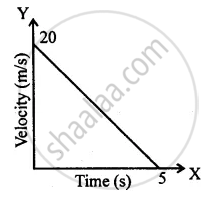
– 4 m/s2
4 m/s2
10 m/s2
zero
Multiple choice Question. Select the correct option.
The distance covered in the adjoining velocity-time graph is :
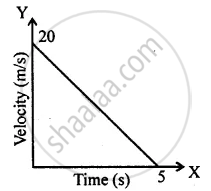
25 m
40 m
50 m
45 m
Multiple choice Question. Select the correct option.
At the maximum height, a body thrown vertically upwards has :
velocity not zero but acceleration zero.
acceleration not zero but velocity zero.
both acceleration and velocity are zero.
both acceleration and velocity are not zero.
Goyal Brothers Prakashan solutions for A New Approach to ICSE Physics Part 1 [English] Class 9 2 Motion in One Dimension Unit II Exercise 2 (B) Subjective Questions
Draw displacement – time graph for the following situation:
When a body is stationary.
Draw displacement – time graph for the following situation:
When a body is moving with uniform velocity.
Draw displacement – time graph for the following situation:
When a body is moving with variable velocity.
Draw velocity – time graph for the following situation:
When a body, is moving with uniform velocity.
Draw velocity – time graph for the following situation:
When a body is moving with variable velocity, but uniform acceleration.
Draw velocity – time graph for the following situation:
When a body is moving with variable velocity, but uniform retardation.
Draw velocity – time graph for the following situation:
When a body is moving with variable velocity and variable acceleration.
How can you find the following?
Velocity from a displacement – time graph.
How can you find the following?
Acceleration from velocity – time graph.
How can you find the following?
Displacement from velocity – time graph.
How can you find the following?
Velocity from acceleration – time graph.
Define the term acceleration due to gravity. State its average value.
State its value in C.G.S. as well as in S.I. system.
When is the acceleration due to gravity positive?
When is the acceleration due to gravity negative?
Can you suggest the kind of motion of a body from the following distance – time graph?
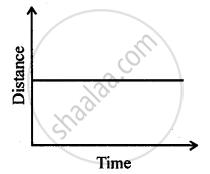
Can you suggest the kind of motion of a body from the following distance – time graph?
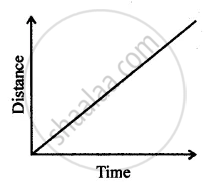
Can you suggest the kind of motion of a body from the following distance – time graph?
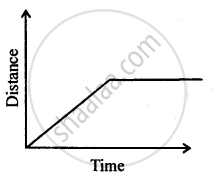
Can you suggest a real-life example about the motion of a body from the following velocity – time graph?
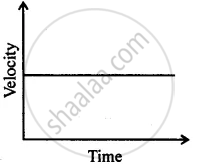
Can you suggest a real-life example about the motion of a body from the following velocity – time graph?
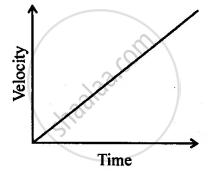
Can you suggest a real-life example about the motion of a body from the following velocity – time graph?
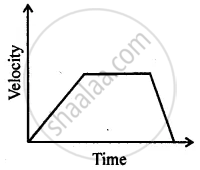
Can you suggest a real-life example about the motion of a body from the following velocity – time graph?
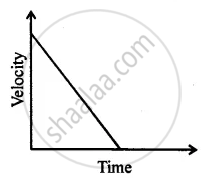
Can you suggest a real-life example about the motion of a body from the following velocity – time graph?
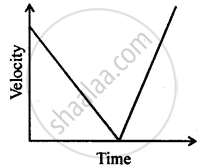
Diagram shows a velocity – time graph for a car starting from rest. The graph has three sections AB, BC and CD.

From a study of this graph, state how the distance travelled in any section is determined.
Diagram shows a velocity – time graph for a car starting from rest. The graph has three sections AB, BC and CD.

Compare the distance travelled in section BC with the distance travelled in section AB.
Diagram shows a velocity – time graph for a car starting from rest. The graph has three sections AB, BC, and CD.

In which section, car has a zero acceleration?
Diagram shows a velocity – time graph for a car starting from rest. The graph has three sections AB, BC, and CD.

Is the magnitude of acceleration higher or lower than that of retardation? Give a reason.
Write down the type of motion of a body along with the A – O – B of the following distance – time graph.
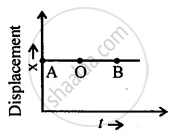
Write down the type of motion of a body along with the A – O – B of the following distance – time graph.

Write down the type of motion of a body along with the A – O – B of the following distance – time graph.
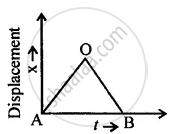
Goyal Brothers Prakashan solutions for A New Approach to ICSE Physics Part 1 [English] Class 9 2 Motion in One Dimension Unit II Practice Problems 1
From the displacement – time graph shown given below calculate:
- Average velocity in the first three seconds.
- Displacement from the initial position at the end of 13 s.
- Time after which the body is at the initial position,
- Average velocity after 8 s.

From the displacement – time graph shown given below calculate :
- Velocity between 0 – 2 s.
- Velocity between 8 s – 12 s.
- Average velocity between 5 s – 12 s.

Goyal Brothers Prakashan solutions for A New Approach to ICSE Physics Part 1 [English] Class 9 2 Motion in One Dimension Unit II Practice Problems 2
A train starting from rest picks up a speed of 20 ms−1 in 200 s. It continues to move at the same rate for the next 500 s and is then brought to rest in another 100 s.
- Plot a speed-time graph.
- From graph calculate
(a) uniform rate of acceleration
(b) uniform rate of retardation
(c) total distance covered before stopping
(d) average speed.
A ball is thrown up vertically and returns back to thrower in 6 s. Assuming there is no air friction, plot a graph between velocity and time. From the graph calculate
- deceleration
- acceleration
- total distance covered by ball
- average velocity.
A racing car is moving with a velocity of 50 m/s. On
applying brakes, it is uniformly retarded and comes to rest in 20 seconds. Calculate its acceleration.
A body falls freely from a certain height. Show graphically the relation between the distance fallen and square of time. How will you determine g from this graph?
A body at rest is thrown downward from the top of the tower. Draw a distance – time graph of its free fall under gravity during the first 3 seconds. Show your table of values starting t = 0 with an interval of 1 second, (g = 10 ms−2).
Goyal Brothers Prakashan solutions for A New Approach to ICSE Physics Part 1 [English] Class 9 2 Motion in One Dimension Unit II Practice Problems 3
From the diagram given below, calculate acceleration.

From the diagram given below, calculate deceleration.

From the diagram given below, calculate distance covered by body.

From the velocity – time graph given below, calculate acceleration in the region AB.

From the velocity – time graph given below, calculate deceleration in region BC.

From the velocity – time graph given below, calculate Distance covered in the region ABCE.

From the velocity – time graph given below, calculate Average velocity in region CED.

Goyal Brothers Prakashan solutions for A New Approach to ICSE Physics Part 1 [English] Class 9 2 Motion in One Dimension Unit II Practice Problems 4
Diagram is given below shows velocity – time graph of car P and Q, starting from the same place and in the same direction. Calculate the Acceleration of car P.

Diagram is given below shows velocity – time graph of car P and Q, starting from the same place and in the same direction. Calculate the Acceleration of car Q between 2 s – 5 s.

Diagram is given below shows velocity – time graph of car P and Q, starting from the same place and in the same direction. Calculate at what time intervals both cars have the same velocity?

Diagram is given below shows velocity – time graph of car P and Q, starting from the same place and in the same direction. Calculate which car is ahead after 10 s and by how much?

Goyal Brothers Prakashan solutions for A New Approach to ICSE Physics Part 1 [English] Class 9 2 Motion in One Dimension Unit III Practice Problems 1
A motorbike, initially at rest, picks up a velocity of 72 kmh−1 over a distance of 40 m. Calculate
- acceleration
- time in which it picks up above velocity.
A cyclist driving at 5 ms−1, picks a velocity of 10 ms−1, over a distance of 50 m. Calculate
- acceleration
- time in which the cyclist picks up above velocity.
Goyal Brothers Prakashan solutions for A New Approach to ICSE Physics Part 1 [English] Class 9 2 Motion in One Dimension Unit III Practice Problems 2
An aeroplane lands at 216 kmh−1 and stops after covering a runway of 2 m. Calculate the acceleration and the time, in which it comes to rest.
A truck running at 90 kmh−1, is brought to rest over a distance of 25 m. Calculate the retardation and time for which brakes are applied.
Goyal Brothers Prakashan solutions for A New Approach to ICSE Physics Part 1 [English] Class 9 2 Motion in One Dimension Unit III Practice Problems 3
A racing car, initially at rest, picks up a velocity of 180 kmh−1 in 4.5 s. Calculate
- acceleration
- distance covered by the car.
A motor bike running at 5 ms−1, picks up a velocity of 30 ms−1 in 5s. Calculate
- acceleration
- distance covered during acceleration.
Goyal Brothers Prakashan solutions for A New Approach to ICSE Physics Part 1 [English] Class 9 2 Motion in One Dimension Unit III Practice Problems 4
A motor bike running at 90 kmh−1 is slowed down to 18 kmh−1 in 2.5 s. Calculate
- acceleration
- distance covered during slow down.
A cyclist driving at 36 kmh−1 stops his motion in 2 s, by the application of brakes. Calculate
- retardation
- distance covered during the application of brakes.
Goyal Brothers Prakashan solutions for A New Approach to ICSE Physics Part 1 [English] Class 9 2 Motion in One Dimension Unit III Practice Problems 5
A motorbike running at 90 kmh−1, is slowed down to 54 kmh−1 by the application of brakes, over a distance of 40 m. If the brakes are applied with the same force, calculate
- total time in which bike comes to rest
- total distance travelled by bike.
A motor car slows down from 72 kmh−1 to 36 kmh−1 over a distance of 25 m. If the brakes are applied with the same force
calculate
- total time in which car comes to rest
- distance travelled by it.
Goyal Brothers Prakashan solutions for A New Approach to ICSE Physics Part 1 [English] Class 9 2 Motion in One Dimension Unit III Practice Problems 6
A packet is dropped from a stationary helicopter, hovering at a height ‘h’ from ground level, reaches the ground in 12s. Calculate
- the value of h
- final velocity of packet on reaching the ground. (Take g = 9.8 ms−2)
A boy drops a stone from a cliff, reaches the ground in 8 seconds. Calculate
- final velocity of stone
- height of cliff. (Take g = 9.8 ms−2)
Goyal Brothers Prakashan solutions for A New Approach to ICSE Physics Part 1 [English] Class 9 2 Motion in One Dimension Unit III Practice Problems 7
A stone thrown vertically upwards takes 3 s to attain maximum height. Calculate
- initial velocity of the stone
- maximum height attained by the stone. (Take g = 9.8 ms−2)
A stone thrown vertically upwards takes 4 s to return to the thrower. Calculate
- initial velocity of the stone
- maximum height attained by stone. (Take g = 10 ms−2)
Goyal Brothers Prakashan solutions for A New Approach to ICSE Physics Part 1 [English] Class 9 2 Motion in One Dimension Unit III Practice Problems 8
A spaceship is moving in space with a velocity of 50 kms−1. Its engine fires for 10 s, such that its velocity increases to 60 kms−1. Calculate the total distance travelled by a spaceship in 1/2 minute, from the time of firing its engine
A spaceship is moving in space with a velocity of 60 kms−1. It fires its retro engines for 20 seconds and velocity is reduced to 55 kms−1. Calculate the distance travelled by a spaceship in 40 s, from the time of firing of the retro- rockets.
Solutions for 2: Motion in One Dimension
![Goyal Brothers Prakashan solutions for A New Approach to ICSE Physics Part 1 [English] Class 9 chapter 2 - Motion in One Dimension Goyal Brothers Prakashan solutions for A New Approach to ICSE Physics Part 1 [English] Class 9 chapter 2 - Motion in One Dimension - Shaalaa.com](/images/a-new-approach-to-icse-physics-part-1-english-class-9_6:5f2b1b2038084cf381bfa42c826a928c.jpg)
Goyal Brothers Prakashan solutions for A New Approach to ICSE Physics Part 1 [English] Class 9 chapter 2 - Motion in One Dimension
Shaalaa.com has the CISCE Mathematics A New Approach to ICSE Physics Part 1 [English] Class 9 CISCE solutions in a manner that help students grasp basic concepts better and faster. The detailed, step-by-step solutions will help you understand the concepts better and clarify any confusion. Goyal Brothers Prakashan solutions for Mathematics A New Approach to ICSE Physics Part 1 [English] Class 9 CISCE 2 (Motion in One Dimension) include all questions with answers and detailed explanations. This will clear students' doubts about questions and improve their application skills while preparing for board exams.
Further, we at Shaalaa.com provide such solutions so students can prepare for written exams. Goyal Brothers Prakashan textbook solutions can be a core help for self-study and provide excellent self-help guidance for students.
Concepts covered in A New Approach to ICSE Physics Part 1 [English] Class 9 chapter 2 Motion in One Dimension are Types of Velocity, Types of Acceleration, Types of Speed, Scalar and Vector Quantities, Velocity - Time Graphs, Measuring the Rate of Motion - Speed with Direction, Distance and Displacement, Acceleration and Retardation, Rate of Change of Velocity, Motion and Rest, Motion Along a Straight Line, Speed, Velocity, Distinguish Between Speed and Velocity, Acceleration Due to Gravity (Earth’s Gravitational Acceleration), Graphical Representation of Motion, Displacement - Time Graph Or Distance - Time Graph, Acceleration - Time Graph, Motion Under Gravity, Equations of Motion by Graphical Method, Derivation of Velocity - Time Relation by Graphical Method.
Using Goyal Brothers Prakashan A New Approach to ICSE Physics Part 1 [English] Class 9 solutions Motion in One Dimension exercise by students is an easy way to prepare for the exams, as they involve solutions arranged chapter-wise and also page-wise. The questions involved in Goyal Brothers Prakashan Solutions are essential questions that can be asked in the final exam. Maximum CISCE A New Approach to ICSE Physics Part 1 [English] Class 9 students prefer Goyal Brothers Prakashan Textbook Solutions to score more in exams.
Get the free view of Chapter 2, Motion in One Dimension A New Approach to ICSE Physics Part 1 [English] Class 9 additional questions for Mathematics A New Approach to ICSE Physics Part 1 [English] Class 9 CISCE, and you can use Shaalaa.com to keep it handy for your exam preparation.
